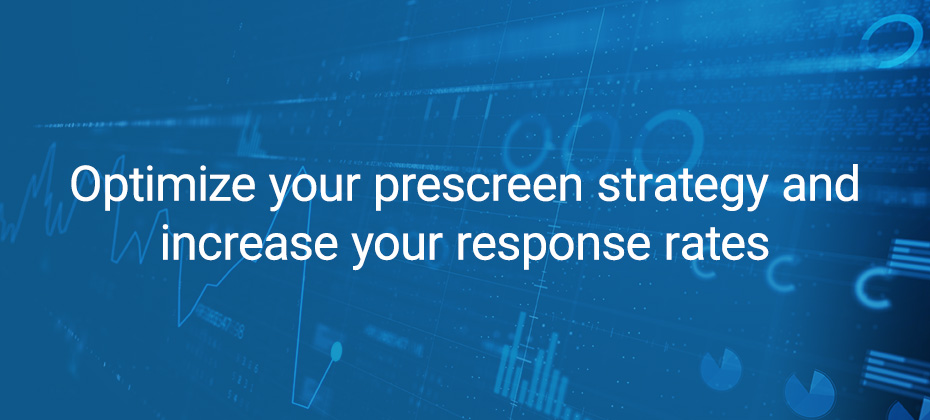Tag: prescreen

In today's competitive market, expanding your organization’s customer base can be a daunting task. Limited marketing budgets, high acquisition costs, and the pressure of financial inclusion initiatives can lead to poor response rates and make it challenging to reach the right consumers. If your prescreen policies are too conservative, you might miss out on valuable opportunities. On the other hand, overly lenient policies can lead to wasted resources on uninterested consumers. So how can you strike the perfect balance and ensure your marketing efforts are both effective and efficient? Challenges for financial institutions Research shows that 55% of financial institutions reported building response models that don’t make it to production.[1] This can lead to wasted time and effort as employees work to build models that are never used, which can have a severe negative impact on organizations’ productivity and team members’ morale. In addition, most organizations are not well-equipped to conduct their own analytics, citing limited access to data for response modeling and challenges with incorporating models into a comprehensive campaign strategy. Many institutions are unsure of who to send offers to, which channels to utilize, which offers to send, or how often to send them. To effectively reach consumers, financial institutions need to: Easily access and understand the right data Quickly move to production Deploy models with little to no friction Monitor and refresh models to avoid deterioration Maintain regulatory compliance So how can your organization accomplish all this to ensure you’re reaching the right consumers with your offers? Ascend Intelligence Services™ Target Ascend Intelligence Services Target (Target) is a cutting-edge solution designed to help businesses target the right consumers with precision. This service leverages custom response models and optimized prescreen strategies to enhance response rates and maximize revenue. At the heart of Target are custom response models developed by industry experts using advanced machine learning (ML) techniques. These models analyze historical data alongside Experian's best-in-class data to identify consumers who meet credit criteria and are more likely to respond to offers. By accurately predicting consumer behavior, these models enable organizations to maximize the return on investment (ROI) of their marketing campaigns and achieve their revenue goals. Additionally, exclusive access to alternative datasets from nontraditional lenders, rental data inputs, and full-file public records provides a comprehensive view of consumer behavior. The inclusion of 24 months of trended data and over 2,000 attributes can further enhance your ability to determine the next best action for each consumer. Watch this video to learn more about Ascend Intelligence Services Target. Optimized prescreen strategy Target's prescreen strategy is mathematically optimized to calculate the impact of your offer on each consumer simultaneously. This approach selects the best consumers to target, allowing you to: Increase response and take-up rates for improved portfolio performance. Minimize prescreen costs by targeting the right people who are more likely to respond to your offers. Expand your lending universe safely and meet diversity and inclusion initiatives by providing the right offer to previously overlooked consumers. Seamlessly integrate into your existing prescreen process for rapid time to value. By incorporating additional variables such as trended and alternative data, you can reach more consumers who might have been overlooked, improving financial inclusion and safely growing your portfolio. The power of optimization allows you to tailor your offers to each consumer, increasing response and take-up rates and enhancing the profitability of your campaigns. Visit our website to learn more about how your organization can utilize our prescreen strategies to maximize your revenue. Learn more [1] Experian research

Getting customers to respond to your credit offers can be difficult. With the advent of artificial intelligence (AI) and machine learning (ML), optimizing credit prescreen campaigns has never been easier or more efficient. In this post, we'll explore the basics of prescreen and how AI and ML can enhance your strategy. What is prescreen? Prescreen involves evaluating potential customers to determine their eligibility for credit offers. This process takes place without the consumer’s knowledge and without any negative impact on their credit score. Why optimize your prescreen strategy? In today's financial landscape, having an optimized prescreen strategy is crucial. Some reasons include: Increased competition: Financial institutions face stiff competition in acquiring new customers. An optimized prescreen strategy helps you stand out by targeting the right individuals with tailored offers, increasing the chances of conversion. Customer expectations: Modern customers expect personalized and relevant offers. An effective prescreen strategy ensures that your offers resonate with the specific needs and preferences of potential customers. Strict budgets: Organizations today are faced with a limited marketing budget. By determining the right consumers for your offers, you can minimize prescreen costs and maximize the ROI of your campaigns. Regulatory compliance: Compliance with regulations such as the Fair Credit Reporting Act (FCRA) is essential. An optimized prescreen strategy helps you stay compliant by ensuring that only eligible individuals are targeted for credit offers. Financial inclusion: 49 million American adults don’t have conventional credit scores. An optimized prescreen strategy allows you to send offers to creditworthy consumers who you may have missed due to a lack of traditional credit history. How AI and ML can enhance your strategy AI and ML can revolutionize your prescreen strategy by offering advanced analytics and custom response modeling capabilities. AI-driven data analytics AI analytics allow financial institutions to analyze vast amounts of data quickly and accurately. This enables you to identify patterns and trends that may not be apparent through traditional analysis. By leveraging data-centric AI, you can gain deeper insights into customer behavior and preferences, allowing for more precise targeting and increased response rates. LEARN MORE: Explore the benefits of AI for credit unions. Custom response modeling Custom response models enable you to better identify individuals who fall within your credit criteria and are more likely to respond to your credit offers. These models consider various factors such as credit history, spending habits, and demographic information to predict future behavior. By incorporating custom response models into your prescreen strategy, you can select the best consumers to engage, including those you may have previously overlooked. LEARN MORE: AI can be leveraged for numerous business needs. Learn about generative AI fraud detection. Get started today Incorporating AI and ML into your prescreen campaigns can significantly enhance their effectiveness and efficiency. By leveraging Experian's Ascend Intelligence Services™ Target, you can better target potential customers and maximize your marketing spend. Our optimized prescreen solution leverages: Full-file credit bureau data on over 245 million consumers and over 2,100 industry-leading credit attributes. Exclusive access to the industry's largest alternative datasets from nontraditional lenders, rental data inputs, full-file public records, and more. 24 months of trended data showing payment patterns over time and over 2,000 attributes that help determine your next best action. When it comes to compliance, Experian leverages decades of regulatory experience to provide the documentation needed to explain lending practices to regulators. We use patent-pending ML explainability to understand what contributed most to a decision and generate adverse action codes directly from the model. For more insights into Ascend Intelligence Services Target, view our infographic or contact us at 855 339 3990. View infographic This article includes content created by an AI language model and is intended to provide general information.

This article was updated on September 8, 2023. Prescreen, prequalification and preapproval. The terms sound similar, but lenders beware. These credit solutions are quite different, and regulations vary depending on which product is utilized. Let’s break it down… What is prescreen? Perhaps the most reliable mailbox tenant, thick envelopes splashed with “limited time offer” or other flashy designations offering various card and credit products – otherwise known as prescreen offers – are a mainstay in many households. Prescreen is a process that happens behind-the-scenes where a lender screens a consumer’s credit to determine whether to extend a firm offer of credit. The process takes place without the consumer’s knowledge and without any negative impact to their credit score. For lenders and financial institutions, credit prescreen is a way to pick and choose the criteria of the consumers you want to target for a particular offer – often in the form of better terms, interest rates or incentives. Typically, a list of consumers meeting specific credit criteria is compiled by a Credit Reporting Agency, like Experian, and then provided to the requesting lending institutions or their mailing service. In other words? Increase response rates and conversion by targeting the right consumers and eliminating unqualified prospects. Additionally, prescreening consumers also reduces high-risk accounts, targeting the best prospects to reach them at the right time with the right offer for their needs. Gone are the days of batch-and-blasting. It’s expensive and a challenge for constantly limited marketing budgets. Prescreen decreases acquisition and mailing costs by segmenting a lender’s prospect list. In one case, a lender identified more than 40 thousand loans, representing $466 million in loan growth opportunities, after using digital prescreen. Governed by the Fair Credit Reporting Act (FCRA), lenders initiating prescreen campaigns for credit products must also adhere to certain rules. What qualifies one of these campaigns? A firm offer of credit An inquiry posting is required (though it is a “soft” inquiry) Consumers also have the option to opt out of preapproved and prescreen credit offer lists In addition to acquisitions via direct mail, there are various types of prescreen tailored to the multiple channels where marketing takes place in today’s world. For example, Instant Prescreen can increase new account acquisitions by performing the preapproval process in seconds, while the customer is on your website, on the phone with you or at your business. Similar to how you might screen calls on your cell phone by letting them go to your voicemail inbox or screen candidates’ resumes before inviting them for an interview for an open position at your company, a prescreened credit offer is not much different. Focusing on your audience that is most likely to respond to your offers is an easy way to increase your ROI and should be considered a best practice when it comes to your marketing efforts. What is prequalification? Prequalification, on the other hand, is a consumer consent-based credit screening tool where the consumer opts-in to see which credit products they may be qualified for in real time at the point of contact. Unlike a prescreen which is initiated by the lender, the prequalification is initiated by the consumer. In this instance, envision a consumer visiting a bank and inquiring about whether they would qualify for a credit card. During a prequalification, the lender can explore if the consumer would be eligible for multiple credit products – perhaps a personal loan or HELOC. The consumer can then decide if they would like to proceed with the offer(s). A soft inquiry is always logged to the consumer’s credit file, and the consumer can be presented with multiple credit options for qualification. No firm offer of credit is required, but adverse action may be required, and it is up to the client’s legal counsel to determine the manner, content, and timing of adverse action. When the consumer is ready to apply, a hard inquiry must be logged to the consumer’s file for the underwriting process. With Experian’s Prequalification, you can match prospective customers with the right loan products at the point of contact, allowing you to increase approval rates and ROI. How will a prequalification or prescreen invitation/offer impact a consumer’s credit report? Inquiries generated by prequalification offers will appear on a consumer’s credit report. For “soft” inquiries, in both prescreen and prequalification instances, there is no impact to the consumer’s credit score. However, once the consumer elects to proceed with officially applying for and/or accepting a new line of credit, the hard inquiry will be noted in the consumer’s report, and the credit score may be impacted. Typically, a hard inquiry subtracts a few points from a consumer’s credit score, but only for a year, depending on the scoring model. Learn more about Prescreen | Learn more about Prequalification

A data-driven customer experience certainly has a nice ring, but can your organization deliver on the promise? What we're really getting at is whether you can provide convenience and personalization throughout the customer journey. Using data to personalize the customer journey About half of consumers say personalization is the most important aspect of their online experience. Forward-thinking lenders know this and are working to implement digital transformations, with 87 percent of business leaders stating that digital acceleration has made them more reliant on quality data and insights. For many organizations, lack of data isn't the issue — it's collecting, cleaning and organizing this data. This is especially difficult if your departments are siloed or if you're looking to incorporate external data. What's more, you would need the capabilities to analyze and execute the data if you want to gain meaningful insights and results. LEARN: Infographic: Automated Loan Underwriting Journey Taking a closer look at two important parts of the customer journey, here's how the right data can help you deliver an exceptional user experience. Prescreening To grow your business, you want to identify creditworthy consumers who are likely to respond to your credit offers. Conversely, it's important to avoid engaging consumers who aren't seeking credit or may not meet your credit criteria. Some of the external data points you can incorporate into a digital prescreening strategy are: Core demographics: Identify your best customers based on core demographics, such as location, marital status, family size, education and household income. Lifestyle and financial preferences: Understand how consumers spend their time and money. Home and auto loan use: Gain insight into whether someone rents or owns a home, or if they'll likely buy a new or used vehicle in the upcoming months. Optimized credit marketing strategies can also use standard (and custom) attributes and scores, enabling you to segment your list and create more personalized offers. And by combining credit and marketing data, you can gain a more complete picture of consumers to better understand their preferred channels and meet them where they are. CASE STUDY: Clear Mountain Bank used Digital Prescreen with Micronotes to extend pre-approved offers to consumers who met their predetermined criteria. The refinance marketing campaign generated over $1 million in incremental loans in just two months and saved customers an average of $1,615. Originations Once your precise targeting strategy drives qualified consumers to your application, your data-driven experience can offer a low-friction and highly automated originations process. Alternative credit data: Using traditional and alternative credit data* (or expanded FCRA-regulated data), including consumer-permissioned data, allows you to expand your lending universe, offer more favorable terms to a wider pool of applicants and automate approvals without taking on additional risk. Behavioral and device data: Leveraging behavioral and device data, along with database verifications, enables you to passively authenticate applicants and minimize friction. Linked and digital applications: Offering a fully digital and intuitive experience will appeal to many consumers. In fact, 81 percent of consumers think more highly of brands after a positive digital experience that included multiple touchpoints. And if you automate verifications and prefill applications, you can further create a seamless customer experience. READ: White paper: Getting AI-driven decisioning right in financial services Personalization depends on persistent identification The vast majority (91 percent) of businesses think that improving their digital customer journey is very important. And rightly so: By personalizing digital interactions, financial institutions can identify the right prospects, develop better-targeted marketing campaigns and stay competitive in a crowded market. DOWNLOAD: A 5-Step Checklist for Identifying Credit-Active Prospect To do this, you need an identity management platform that enables you to create a single view of your customer based on data streams from multiple sources and platforms. From marketing to account management, you can use this persistent identity to inform your decisions. This way, you can ensure you're delivering relevant interactions and offers to consumers no matter where they are. WATCH: Webinar: Omnichannel Marketing - Think Outside the Mailbox Personalization offers a win-win Although they want personalization, only 33 percent of consumers have high confidence in a business' ability to recognize them repeatedly.4 To meet consumer expectations and remain competitive, you must deliver digital experiences that are relevant, seamless, and cohesive. Experian Consumer View helps you make a good first impression with consumer insights based on credit bureau and modeled data. Enrich your internal data, and use segmentation solutions to further refine your target population and create offers that resonate and appeal. You can then quickly deliver customized and highly targeted campaigns across 190 media destinations. From there, the Experian PowerCurve® Originations Essentials, an automated decisioning engine, can incorporate multiple external and internal data sources to optimize your strategy. *Disclaimer: When we refer to “Alternative Credit Data," this refers to the use of alternative data and its appropriate use in consumer credit lending decisions, as regulated by the Fair Credit Reporting Act. Hence, the term “Expanded FCRA Data" may also apply in this instance and both can be used interchangeably.

"Out with the old and in with the new" is often used when talking about a fresh start or change we make in life, such as getting a new job, breaking bad habits or making room in our closets for a new wardrobe. But the saying doesn't exactly hold true in terms of business growth. While acquiring new customers is critical, increasing customer retention rates by just 5% can increase profits by up to 95%.1 So, what can your organization do to improve customer retention? Here are three quick tips: Stay informed Keeping up with your customers’ changing interests, behaviors and life events enables you to identify retention opportunities and create personalized credit marketing campaigns. Are they new homeowners? Or likely to purchase a vehicle within the next five months? With a comprehensive consumer database, like Experian’s ConsumerView®, you can gain granular insights into who your customers are, what they do and even what they will potentially do. To further stay informed, you can also leverage Retention TriggersSM, which alert you of your customers changing credit needs, including when they shop for new credit, open a new trade or list their property. This way, you can respond with immediate and relevant retention offers. Be more than a business – be human Gen Z's spending power is projected to reach $12 trillion by 2030, and with 67% looking for a trusted source of personal finance information,2 financial institutions have an opportunity to build lifetime loyalty now by serving as their trusted financial partners and advisors. To do this, you can offer credit education tools and programs that empower your Gen Z customers to make smarter financial decisions. By providing them with educational resources, your younger customers will learn how to strengthen their financial profiles while continuing to trust and lean on your organization for their credit needs. Think outside the mailbox While direct mail is still an effective way to reach consumers, forward-thinking lenders are now also meeting their customers online. To ensure you’re getting in front of your customers where they spend most of their time, consider leveraging digital channels, such as email or mobile applications, when presenting and re-presenting credit offers. This is important as companies with omnichannel customer engagement strategies retain on average 89% of their customers compared to 33% of retention rates for companies with weak omnichannel strategies. Importance of customer retention Rather than centering most of your growth initiatives around customer acquisition, your organization should focus on holding on to your most profitable customers. To learn more about how your organization can develop an effective customer retention strategy, explore our marketing solutions. Increase customer retention today 1How investing in cardholder retention drives portfolio growth, Visa. 2Experian survey, 2023.

For a credit prescreen marketing campaign to be successful, financial institutions must first define their target audience. But just because you’ve identified your ideal customers, it doesn’t mean that every individual within that group has the same needs, interests or behaviors. As such, you’ll need to use data-driven customer segmentation to create messages and offers that truly resonate. Customer segmentation example Customer segmentation is the practice of dividing your target audience into smaller sub-groups based on shared characteristics, behaviors or preferences. This allows you to develop highly targeted marketing campaigns and engage with individual groups in more relevant and meaningful ways. What role does data play in customer segmentation? When it comes to segmenting customers, there isn’t a one-size-fits-all approach that works perfectly for all campaigns and markets. However, regardless of the campaign, you’ll need accurate and relevant data to inform your segmenting strategy. Let’s walk through a customer segmentation example. Say you want to launch a credit marketing campaign that targets creditworthy consumers in the market for a new mortgage. Some of the most influential data points to consider when segmenting include: Demographics Demographic data allows you to get to know your customers as individuals in terms of age, gender, education, occupation and marital status. If you want to create a segment that consists of only middle-aged consumers, leveraging demographic data makes it easier to identify these individuals, refine your messaging and predict their future buying behaviors. Life stage Life event data, such as new parents and new homeowners, helps you connect with consumers who have experienced a major life event. Because you’re targeting consumers in the market for a new mortgage, using fresh and accurate life stage data can help you create an engaging, event-based marketing campaign relevant to their timeline. Financial Financial data segments go beyond income and estimate the way consumers spend their money. With deeper insights into customers’ financial behaviors, you can more accurately assess creditworthiness and make smarter lending decisions. Transactional Transactional data segments group your customers according to their unique buying habits. By getting to know why they purchase your products or their frequency of spend, you can gain a better understanding of who your most engaged customers are, segment further and find opportunities for cross-sell and upsell. Why is data-driven customer segmentation critical for your business? With data-driven customer segmentation, you can develop relevant marketing campaigns and messages that speak to specific audiences, enabling you to demonstrate your value propositions more clearly and deliver personalized customer experiences. Additionally, because customer segmentation enables you to tailor your marketing efforts to those most likely to respond, you can achieve higher conversions while cutting down on marketing spend and resources. Ready to get started? While data-driven customer segmentation may seem overwhelming, Experian can help fill your marketing gaps with custom-based data, audiences and solutions. Armed with a better understanding of your consumers’ patterns and journeys, you can start targeting them more effectively. Create highly targeted credit marketing campaigns

With an abundance of loan options in today’s market, retaining customers can be challenging for banks and credit unions, especially small or regional institutions. And as more consumers look for personalization and digital tools in their banking experience, the likelihood of switching to institutions that can meet these demands is increasing.1 According to a recent Experian survey, 78% of consumers have conducted personal banking activities online in the last three months. However, 58% of consumers don’t feel that businesses completely meet their expectations for a digital online experience. To remain competitive in today's market, organizations must enhance their prescreen efforts by accelerating their digital transformation. Prescreen in today's economic environment While establishing a strong digital strategy is crucial to meeting the demands of today’s consumers, economic conditions are continuing to change, causing many financial institutions to either tighten their marketing budgets or hold off on their prescreen efforts completely. Fortunately, lenders can still drive growth during a changing economy without having to make huge cuts to their marketing budgets. How? The answer lies in digital prescreen. Case study: Uncover hidden growth opportunities Wanting to grow their business and existing relationships, Clear Mountain Bank looked for a solution that could help them engage customers with money-saving product offers while delivering a best-in-class digital banking experience. Leveraging Digital Prescreen with Micronotes, the bank was able to identify and present dollarized savings to customers who held higher-priced loans with other lenders. What’s more, the bank extended these offers through personalized conversations within their online and mobile banking platforms, resulting in improved digital engagement and increased customer satisfaction. By delivering competitive prescreen offers digitally, Clear Mountain Bank generated more than $1 million in incremental loans and provided customers with an average of $1,615 in cost savings within the first two months of deployment. “Digital Prescreen with Micronotes supplied the infrastructure to create higher-quality, personalized offers, as well as the delivery and reporting. They made prescreen marketing a reality for us.” – Robert Flockvich, Director of Community Outreach and Retail Lending at Clear Mountain Bank To learn more about how you can grow your portfolio and customer relationships, read the full case study or visit us. Download the case study Visit us 1The Keys to Solving Banking’s Customer Loyalty & Retention Problems, The Financial Brand, 2022.

Financial institutions have gone through a whirlwind in the last few years, with the pandemic forcing many to undergo digital transformations. More recently, rising interest rates and economic uncertainty are leading to a pullback, highlighting the need for lenders to level up their marketing strategies to win new customers. To get started, here are a few key trends to look out for in the new year and fresh marketing ideas for lenders. Challenges and consumers expectations in 2023 It might be cliche to mention the impact that the pandemic had on digital transformations — but that doesn't make it any less true. Consumers now expect a straightforward online experience. And while they may be willing to endure a slightly more manual process for certain purchases in their life, that's not always necessary. Lenders are investing in front-end platforms and behind-the-scenes technology to offer borrowers faster and more intuitive services. For example, A McKinsey report from December 2021 highlighted the growth in nonbank mortgage lenders. It suggested nonbank lenders could hold onto and may continue taking market share as these tech-focused lenders create convenient, fast and transparent processes for borrowers.2 Marketers can take these new expectations to heart when discussing their products and services. To the extent you have one in place, highlight the digital experience that you can offer borrowers throughout the application, verifications, closing and loan servicing. You can also try to show rather than tell with interactive online content and videos. Build a data-driven mortgage lending marketing strategy The McKinsey report also highlighted a trend in major bank and nonbank lenders investing in proprietary and third-party technology and data to improve the customer experience.2 Marketers can similarly turn to a data-driven credit marketing strategy to help navigate shifting lending environments. Segment prospects with multidimensional data Successful marketers can incorporate the latest technological and multidimensional data sources to find, track and reach high-value prospects. By combining traditional credit data with marketing data and Fair Credit Report Act-compliant alternative credit data* (or expanded FCRA-regulated data), you can increase the likelihood of connecting with consumers who meet your credit criteria and will likely respond. For example, Experian's mortgage-specific In the Market Models predict a consumer's propensity to open a new mortgage within a one to four-month period based on various inputs, including trended credit data and Premier Attributes. You can use these propensity models as part of your prescreen criteria, to cross-sell current customers and to help retain customers who might be considering a new lender. But propensity models are only part of the equation, especially when you're trying to extend your marketing budget with hyper-segmented campaigns. Incorporating your internal CRM data and non-FCRA data can help you further distinguish look-alike populations and help you customize your messaging. LEARN MORE: Use this checklist to find and fix gaps in your prospecting strategy Maintain a single view of your borrowers An identity management platform can give you a single view of a consumer as they move through the customer journey. The persistent identity can also help you consistently reach consumers in a post-cookie world and contact them using their preferred channel. You can add to the persistent identity as you learn more about your prospects. However, you need to maintain data accuracy and integrity if you want to get a good ROI. Use triggers to guide your outreach You can also use data-backed credit triggers to implement your marketing plan. Experian's Prospect Triggers actively monitors a nationwide database to identify credit-active consumers who have new tradelines, inquiries or a loan nearing term. Lenders using Prospect Triggers can receive real-time or periodic updates and customize the results based on their screening strategy and criteria, such as score ranges and attributes. They can then make firm credit offers to the prospects who are most likely to respond, which can improve cross-selling opportunities along with originations. Benefit from our expertise Forward-thinking lenders should power their marketing strategies with a data-backed approach to incorporate the latest information from internal and external sources and reach the right customer at the right time and place. From list building to identity management and verification, you can turn to Experian to access the latest data and analytics tools. Learn about Experian credit prescreen and marketing solutions. Explore our credit prescreen solutions Learn about our marketing solutions 1Mortgage Bankers Association (October 2022). Mortgage Applications Decrease in Latest MBA Weekly Survey 2McKinsey & Company (2021). Five trends reshaping the US home mortgage industry

With consumers having more credit options than ever before, it’s imperative for lenders to get their message in front of ideal customers at the right time and place. But without clear insights into their interests, credit behaviors or financial capacity, you may risk extending preapproved credit offers to individuals who are unqualified or have already committed to another lender. To increase response rates and reduce wasted marketing spend, you must develop an effective customer targeting strategy. What makes an effective customer targeting strategy? A customer targeting strategy is only as good as the data that informs it. To create a strategy that’s truly effective, you’ll need data that’s relevant, regularly updated, and comprehensive. Alternative data and credit-based attributes allow you to identify financially stressed consumers by providing insight into their ability to pay, whether their debt or spending has increased, and their propensity to transfer balances and consolidate loans. With a more granular view of consumers’ credit behaviors over time, you can avoid high-risk accounts and focus only on targeting individuals that meet your credit criteria. While leveraging additional data sources can help you better identify creditworthy consumers, how can you improve the chances of them converting? At the end of the day, it’s also the consumer that’s making the decision to engage, and if you aren’t sending the right offer at the precise moment of interest, you may lose high-value prospects to competitors who will. To effectively target consumers who are most likely to respond to your credit offers, you must take a customer-centric approach by learning about where they’ve been, what their goals are, and how to best cater to their needs and interests. Some types of data that can help make your targeting strategy more customer-centric include: Demographic data like age, gender, occupation and marital status, give you an idea of who your customers are as individuals, allowing you to enhance your segmentation strategies. Lifestyle and interest data allow you to create more personalized credit offers by providing insight into your consumers’ hobbies and pastimes. Life event data, such as new homeowners or new parents, helps you connect with consumers who have experienced a major life event and may be receptive to event-based marketing campaigns during these milestones. Channel preference data enables you to reach consumers with the right message at the right time on their preferred channel. Target high-potential, high-value prospects By using an effective customer targeting strategy, you can identify and engage creditworthy consumers with the greatest propensity to accept your credit offer. To see if your current strategy has what it takes and what Experian can do to help, view this interactive checklist or visit us today. Review your customer targeting strategy Visit us

From desktops and laptops to smartphones and tablets, consumers leverage multiple devices when engaging with businesses. For financial institutions, it’s important to identify and track consumers across devices to deliver personalized offers and increase opportunities for conversion. The problem with cookies Marketers have traditionally used cookies to determine what their audience’s interests are based on their browsing activity and past purchases. An example of this is when a user browses a product on a website and then leaves without buying. Later that day, they see an ad on social media featuring the same product they viewed earlier. While this may seem like an effective way for financial institutions to target or prescreen consumers, cookies are very limited — they can’t capture or connect a user’s behavior across multiple touchpoints. In other words, if a consumer were to browse a website on their mobile phone and then switch to their laptop, the business would view these sessions as two different visits from two different people, resulting in inconsistent messaging and a disjointed user experience. This is a huge problem because devices don’t decide to convert — people do. To reach the right consumers with the right message wherever they may be, financial institutions must look beyond cookies. This is where people-based marketing comes in. What is people-based marketing? People-based marketing takes a more personal marketing approach. Rather than targeting devices, people-based marketing connects businesses with real people, helping them understand who their customers are, what they’re looking for and how to engage them in more meaningful ways. It does this by gathering customer data from both online and offline sources to create a single customer profile. Let’s look at an example of people-based marketing by revisiting the scenario above. A user is browsing a company’s website on their mobile phone and decides to switch to their laptop. By capturing a single view of the user with a people-based marketing solution, the brand can recognize them and resume their experience on the new device. What’s more, the brand understands the user’s intent at that stage of their customer journey and leverages real-time data to make relevant offers and recommendations, helping further personalize their experience. Benefits of a people-based marketing approach To create better-targeted credit marketing campaigns, financial institutions must ensure they have the right data and technologies in place. Experian’s industry-leading database technology provides the freshest, most comprehensive consumer credit data to help organizations optimize their lending criteria and marketing campaigns. With Experian’s people-based marketing solutions, financial institutions can: Reach the right people: Leveraging fresh consumer data allows financial institutions to target the best prospects for their business needs and avoid making preapproved offers to nonqualified consumers. Deliver personalized credit offers: By gaining a more complete view of consumers, financial institutions can ensure they’re sending relevant offers to users where and when they’re most motivated to respond. Enhance their retargeting efforts: If a user isn’t ready to convert upon their first interaction, organizations can reach them on another device to reinforce their messaging in more personalized ways. Provide frictionless, omnichannel experiences: Seamless identity resolution allows organizations to accurately recognize consumers across devices, leading to more precise targeting and cohesive customer experiences. Reduce marketing spend: By focusing on the right audience with the right message, organizations can avoid unlikely prospects and reduce wasted marketing spend, all while increasing response rates. Expand their reach: With rich insights into their clients’ interests, demographics and behaviors, financial institutions can target prospects who share similar characteristics and are likely to convert. Leveraging an effective people-based marketing strategy is crucial to delivering personalized and consistent customer experiences in today’s multi-device world. To learn more about how Experian can help, visit us today. Learn about our people-based marketing solutions

To grow in today’s economic climate and beat the competition, financial institutions need to update their acquisition and cross-sell strategies. By doing so, they are able to drive up conversions, minimize risk, and ultimately connect consumers with the right offers at the right time. Businesses and consumers are spending more time online than ever before, with 40% of consumers increasing the number of businesses they visit online. They’ve also made it clear that they expect easy, frictionless transactions with their providers. This includes new accounts and offers of credit – creating the need for better delivery systems. Effective targeting and conversion come down to more than just direct mail and email subject lines, especially now in a volatile economy where consumers are seeking appropriate products for their current situation. Be the first to meet consumers’ needs by leveraging the freshest data, advanced analytics, and automated decision systems. For example, when a consumer tries to open a checking account, the system can initiate a “behind-the-scenes” real-time prescreen request while assessing information needed to open the deposit account. The financial institution can then see if the consumer qualifies for overdraft protection, refinancing offers, loans, credit cards, and more. By performing the pre-approval process in seconds, financial institutions can be sure that they're making the right offers to the right customer, and doing it at the right time. All of this helps to increase the offer acceptance rate, improving customer retention, and maximizing customer account life-time value. The pandemic upended a lot of the ways that your businesses run day-to-day – from where you work to how you (better) engage with customers. Arguably, some of the changes have been long overdue, particularly the acceleration to digital and better customer acquisition strategies. Ahead lies the opportunity to grow – strategies enacted now will determine the extent of that opportunity. To learn more about how Experian can help you assess your prescreen strategy and grow, contact us today. Request a call

With 2020 firmly behind us and multiple COVID-19 vaccines being dispersed across the globe, many of us are entering 2021 with a bit of, dare we say it, optimism. But with consumer spending and consumer confidence dipping at the end of the year, along with an inversely proportional spike in coronavirus cases, it’s apparent there’s still some uncertainty to come. This leaves businesses and consumers alike, along with fintechs and their peer financial institutions, wondering when the world’s largest economy will truly rebound. But based on the most recent numbers available from Experian, fintechs have many reasons to be bullish. In this unprecedented year, marked by a global pandemic and a number of economic and personal challenges for both businesses and consumers, Americans are maintaining healthy credit profiles and responsible spending habits. While growth expectedly slowed towards the end of the year, Q4 of 2020 saw solid job gains in the US labor market, with 883,000 jobs added through November and the US unemployment rate falling to 6.7%. Promisingly, one of the sectors hit hardest by the pandemic, the leisure and hospitality industry added back the most jobs of all sectors in October: 271,000. Additionally, US home sales hit a 14-year high fueled by record low mortgage rates. And finally, consumer sentiment rose to the highest level (81.4%) since March 2020. Not only are these promising signs of continued recovery, they illustrate there are ample market opportunities now for fintechs and other financial institutions. “It’s been encouraging to see many of our fintech partners getting back to their pre-COVID marketing levels,” said Experian Account Executive for Fintech Neil Conway. “Perhaps more promising, these fintechs are telling me that not only are response rates up but so is the credit quality of those applicants,” he said. More plainly, if your company isn’t in the market now, you’re missing out. Here are the four steps fintechs should take to reenter the lending marketing intelligently, while mitigating as much risk as possible. Re-do Your Portfolio Review Periodic portfolio reviews are standard practice for financial institutions. But the health crisis has posted unique challenges that necessitate increased focus on the health and performance of your credit portfolio. If you haven’t done so already, doing an analysis of your current lending portfolio is imperative to ensure you are minimizing risk and maximizing profitability. It’s important to understand if your portfolio is overexposed to customers in a particularly hard-hit industry, i.e. entertainment, or bars and restaurants. At the account level there may be opportunities to reevaluate customers based on a different risk appetite or credit criteria and a portfolio review will help identify which of your customers could benefit from second chance opportunities they may not have otherwise been able to receive. Retool Your Data, Analytics and Models As the pandemic has raged on, fintechs have realized many of the traditional data inputs that informed credit models and underwriting may not be giving the complete picture of a consumer. Essentially, a 720 in June 2020 may not mean the same as it does today and forbearance periods have made payment history and delinquency less predictive of future ability to pay. To stay competitive, fintechs must make sure they have access to the freshest, most predictive data. This means adding alternative data and attributes to your data-driven decisioning strategies as much as possible. Alternative data, like income and employment data, works to enhance your ability to see a consumer’s entire credit portfolio, which gives lenders the confidence to continue to lend – as well as the ability to track and monitor a consumer’s historical performance (which is a good indicator of whether or not a consumer has both the intention and ability to repay a loan). Re-Model Your Lending Criteria One of the many things the global health crisis has affirmed is the ongoing need for the freshest, most predictable data inputs. But even with the right data, analytics can still be tedious, prolonging deployment when time is of the essence. Traditional models are too slow to develop and deploy, and they underperform during sudden economic upheavals. To stay ahead in times recovery or growth, fintechs need high-quality analytics models, running on large and varied data sets that they can deploy quickly and decisively. Unlike many banks and traditional financial institutions, fintechs are positioned to nimbly take advantage of market opportunities. Once your models are performing well, they should be deployed into the market to actualize on credit-worthy current and future borrowers. Advertising/Prescreening for Intentional Acquisition As fintechs look to re-enter the market or ramp up their prescreen volumes to pre-COVID levels, it’s imperative to reach the right prospects, with the right offer, based on where and how they’re browsing. More consumers than ever are relying on their phones for browsing and mobile banking, but aligning messaging and offers across devices and platforms is still important. Here’s where data-driven advertising becomes imperative to create a more relevant experience for consumers, while protecting privacy. As 2021 rolls forward, there will be ample chance for fintechs to capitalize on new market opportunities. Through up-to-date analysis of your portfolio, ensuring you have the freshest, predictive data, adjusting your lending criteria and tweaking your approach to advertising and prescreen, you can be ready for the opportunities brought on by the economic recovery. How is your fintech gearing up to re-enter the market? Learn more

As industry experts are still unsure when the economy will fully recover, re-entry into marketing preapproved credit offers seems like a far-off proposal. However, several of the top credit card issuers are already mailing prescreen offers, with many other lenders following suit. When the time comes for organizations to resume, or even expand this type of targeting, odds are that the marketing budget will be tighter than in the past. To make the most of the limited available marketing spend, lenders will need to be more prescriptive with their selection process to increase response rates on fewer delivered offers. Choosing the best candidates to receive these offers, from a credit risk perspective, will be critical. With delinquencies being suppressed due to CARES Act reporting guidelines, identifying consumers with the ability to repay will require additional assessment of recent credit behavior metrics, such as actual payment amounts and balance migration. Along with the presence of explicit indicators of accommodated trades (trades affected by natural disaster, trades with a balance but no scheduled payment amount) on a prospect’s credit file, their recent trends in payments and balance shifts can be integral in determining whether a prospect has been adversely impacted by today’s economic environment. Once risk criteria have been developed using a mix of bureau scores (like the VantageScore® credit score), traditional credit attributes and trended attributes measuring recent activity, additional targeting will be critical for selecting a population that’s most likely to open the relevant trade type. For credit cards and personal installment loans, response performance can be greatly improved by aligning product offers with prospects based on their propensity to revolve, pay in full each month or consolidate balances. Additionally, the process to select final prospects should integrate a propensity to open/respond assessment for the specific offering. While many lenders have custom models developed on previous internal response performance, off-the-shelf propensity to open models are also available to provide an assessment of a prospect’s likelihood to open a particular type of trade in the coming months. These models can act as a fast-start for lenders that intend to develop internal custom models, but don’t have the response performance within a particular product/geography/risk profile. They are also commonly used as a long-term solution for lenders without an internal model development team or budget for an outsourced model. Prescreen selection best practices Identify geography and traditional credit risk assessment of the prospect universe. Overlay attributes measuring accommodated trades and recent payment/balance trends to identify prospects with indications of ability to pay. Segment the prospect universe by recent credit usage to determine products that would resonate. Make final selections using propensity to open model scores to increase response rates by only making offers to consumers who are likely looking for new credit offers. While the best practices listed above don’t represent a risk-free approach in these uncertain times, they do provide a framework for identifying prospects with mitigated repayment risk and insights into the appropriate credit offer to make and when to make it. Learn about in the market models Learn about trended attributes VantageScore® is a registered trademark of VantageScore Solutions, LLC.

Big Data, once thought to be overhyped consultant-speak, is now a term and business model so ubiquitous it underpins billions of dollars in revenue across nearly every industry. Similarly, the advanced analytics derived from big data are key to staying relevant in an everchanging global economy and to consumers with expanding expectations. But for many financial institutions, using big data and advanced analytics seemed to only be in reach for big banks with large, advanced data teams. With the expansion of the Experian Ascend Technology PlatformTM, the conversation is changing. Financial institutions of all sizes can now leverage advanced analytics, artificial intelligence and machine learning with new configurations in the award-winning platform. In a release earlier this week, Experian announced new tools and configurations in the Ascend Analytical SandboxTM to fit teams of every size and skill level. Now fintechs, banks and credit unions of every size can have access to Experian’s one-stop source for advanced analytics, business intelligence and ultimately, better decisions. The secure hybrid-cloud environment allows users to combine their own data sets with Experian’s exclusive data assets, including credit, alternative, commercial, auto and more. From there, users can build and test models across different stages of the lending cycle, including originations, prescreen, account management and collections, and seamlessly put their models into production. Experian’s Ascend Analytical Sandbox also allows users to benchmark their portfolios against the industry, identify credit trends and explore new product opportunities. All the insights gathered through the Ascend Analytical Sandbox can be viewed and shared through interactive dashboards and customizable reports that can be pulled in near real time. Additional use cases include: Reject inferencing – refine models, scorecards and strategies by analyzing trades opened by previous applicants who were rejected or approved but did not move forward Prescreen campaigns – design prescreen campaigns, evaluate results and improve strategies Cross-sell – identify cross-sell opportunities for existing customers and identify how they may be working with other lenders Collections strategies, stress testing and loss forecasting – build stronger models to identify customers that have ability and willingness to pay debts, stress test and forecast loss Peer benchmarking and industry trends – compare current portfolio against peers and the industry Recession planning – identify areas to adjust your portfolio to prepare for an economic downturn OneMain Financial, a large provider of personal installment loans serving 10 million total customers across more than 1,700 branches, turned to Experian to improve its risk modeling and credit portfolio management capabilities with the Ascend Analytical Sandbox. Since using the solution, the company has seen significant improvements in reject inferencing – a process that is traditionally expensive, manually-intensive and time consuming. According to OneMain Financial, the Ascend Analytical Sandbox has shortened the process to less than two weeks from up to 180 days. "Experian's Ascend Technology Platform and Analytical Sandbox is an industry gamechanger," said Michael Kortering, OneMain Financial's Senior Managing Director and Head of Model Development. "We're completing analyses that just weren't possible before and we're getting decisions to our clients faster, without compromising risk.” For more information on Ascend Analytical Sandbox SX – the latest solution for financial institutions of all sizes – or other enterprise-wide capabilities of the Experian Ascend Technology Platform, click here.

There are about as many definitions for people-based marketing as there are companies using the term. Each company seems to skew the definition to fit their particular service offering. The distinctions are vast, and especially for financial services companies running regulated campaigns, they can be incredibly important. At Experian, we define people-based marketing in its purest form: targeting at the individual level across channels. This is a practice we’re very familiar with in offline marketing, having honed arguably one of the most accurate views of U.S. consumers over the past three decades. And now we’re taking those tried and true principals and applying them to digital channels. It’s not as easy as it sounds. The challenge with people-based marketing With direct mail, people-based marketing was easy. Jane Doe lives at 123 Main St. If I want to reach her, I can simply send her a direct mail piece at that address. To help, I can utilize any number of services, including the National Change of Address database, to know where to reach her if she ever moves. People-based marketing through digital channels is exponentially more difficult. While direct mail has one signal with which you use to identify a consumer (the address), digital channels offer countless signals. And not all of those signals can be used, either individually or in conjunction with other signals, to reliably tie a consumer to a persistent offline ID. A prime example of this is cookies. The problem with cookies A cookie, in and of itself, isn’t the problem. The problem is the linkage. How was a cookie associated with the person to whom the ad is being served? As marketers, we need to make sure that we are reaching the right people with the right ad … and more importantly not reaching those people who have opted out. This is especially true in the world of regulated data, where you need to know who you are targeting. And cookie-based linkage is controlled by a handful of companies, many of which are walled gardens who don’t share how they link offline people to online cookies and don’t collect this information directly. They rely on other third-party websites to gather PII, and connect it to their cookies. In some cases, the data is very accurate (especially with transaction data). In some cases, it is not (think websites that collect PII when giving surveys, offering coupons, etc.). In short, in order for you to use cookie-based targeting accurately, you need to have insight into the source of the base linkage data that was used to connect the offline consumer record to the online cookie. This same concept applies to all forms of digital linkage that drive people-based marketing. Why does people-based marketing matter in digital credit marketing? With campaigns that utilize non-regulated data, such as “Invitation to Apply” campaigns that are driven from demographic and psychographic data, the consequences of not reaching the consumer you meant to target are negligible. But with campaigns that utilize regulated data, you must ensure you’re targeting the exact consumer you meant to reach. More importantly, you must make sure you’re not targeting an ad to a consumer who had previously opted out of receiving offers driven with regulated data (prescreen offers, for example). Even if you’ve already delivered a direct mail piece with the same offer, this doesn’t negate your responsibility to reach only approved consumers who have not opted out. --- Bottom line, the world of 1:1 marketing is growing more sophisticated, and that’s a good thing. Marketers just need to understand that while regulated data can be powerful, they must also take great responsibility when handling it. The data exists to deliver firm offers of credit to your very specific target in all-new mediums. People-based marketing has its place, and it can now be done in a compliant, digitally-savvy way – in the financial services space, nonetheless. Register for our webinar on Credit Marketing Strategies to Drive Today's Digital Consumer.